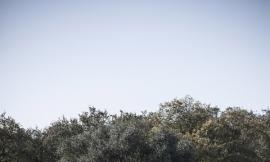德国斯图加特大学最近完成了一座计算式设计,仿生式结构,采用机器人精度制造与建造的木材展览馆---Landesgartenschau展览馆。
Landesgartenschau展览馆的结构系统非常复杂,但是在上述的技术支持下实现了完成,不小的体量之中,每块木板的厚度仅5厘米,整个建造只使用了当地12立方木的山榉木。其高效利用木材的方式非常符合可持续的木能源发展战略。而其全新的结构体系和快速建造也为木材这种古老的材料带来了更多的可能性。
Appreciation towards University of Stuttgart for providing the following description:
All Images ? ICD/ITKE/IIGS University of Stuttgart

Landesgartenschau展览馆是一个构架原型建筑,集中展现了当前采用参数化设计和机器人加工方法筑造轻型木结构建筑的发展成果。展览馆由欧盟和巴登符腾堡州共同出资建成,是第一座基本结构完全采用机器人预制的山毛榉胶合板构成的建筑。这座新建的木结构体不仅为建筑领域带来了创新的可能性,还具有高效节能的特点,其承重结构板仅50mm厚。项目采用的综合参数化设计,模拟、制造和测量方法让这些成为可能。
The Landesgartenschau Exhibition Hall is an architectural prototype building and a showcase for the current developments in computational design and robotic fabrication for lightweight timber construction. Funded by the European Union and the state of Baden‐Württemberg, the building is the first to have its primary structure entirely made of robotically prefabricated beech plywood plates. The newly developed timberconstruction offers not only innovative architectural possibilities; it is also highly resource efficient, with the load bearing plate structure being just 50mm thin. This is made possible through integrative computational design, simulation, fabrication and surveying methods.


展馆主要分为两个空间:入口空间和主要展览空间。每个空间都近似一个圆拱形,两个空间相连之处有一个收缩边缘。人们从壳下进入空间,最终到达顶高6米的主空间,通过大型的终端玻璃幕墙观赏周围的景观。在建筑内部,建筑的几何形状与胶合板及其咬合的关节都是建筑强烈的特征。凸状的几何形体实现空间。源于生物系统的几何分化原则清晰可见并成为建筑体验的一部分。

The Landesgartenschau Exhibition Hall is organized into two individual spatial zones that are differentiated through the building’s overall geometry: the entrance space and the main exhibition space. In both zones the plate structure is dome‐shaped consisting of convex polygonal plates. An intermediate space or transition zone is defined by a saddle‐shaped spatial contraction where the shell consists of concave polygonal plates. Visitors enter the building through the lower part of the shell and are guided through the slight narrowing of the structure to the 6 metershigh main space with its large glass facade opening towards the surrounding landscape. The interior is characterised not only by its global geometry,but particularly by the plywood plates and their visible finger joint connections. The geometric gradient between convex and concave polygonal plates emphasises the spatial arrangement. The construction principles that were derived from the geometric differentiation of biological systems remain visible and become part of the architectural experience.






Landesgartenschau展览馆是斯图加特大学“机器人建造木材”项目的一部分,与ForstBW和KUKA 机器人技术有限公司共同合作实现。这个项目因其计算的方法,仿真以及其制造的方法,为本地可再生的木材资源利用带来了全新的机遇。在这个项目中,机器人制造的模板结构体系---榉木胶合板是一种创新的轻便结构体系。由计算研究所设计(ICD,Achim Menges教授),建筑结构研究所和结构设计(ITKE,Jan Knippers教授),工程测量学研究所(IIGS,Volker Schwieger教授)和开发实现与 Müllerblaustein Holzbau 有限公司共同完成。项目也是一年两次的ForstBW展览中重要的展出项目。项目的其余资金则由欧洲地区基金会(ERDF)与Forst und Holz的系列合作伙伴提出。
The Landesgartenschau Exhibition Hall was conceived at the University of Stuttgart as part of the “Robotics in Timber Construction” research project and realized in collaboration with Müllerblaustein Holzbau GmbH, Landesgartenschau Schw?bisch Gmünd 2014 GmbH, the forest administration of Baden‐Württemberg (ForstBW) and KUKA Robotics GmbH. The project demonstrates the new opportunities that arise fromthe integration of computational design, simulation and fabrication methods for performative and resource efficient constructions made from thelocally available and renewable resource wood. The building introduces an innovative, robotically fabricated lightweight timber plate constructionsystem made of beech plywood. It was developed at the Institute for Computational Design (ICD, Prof. Achim Menges), the Institute of Building
Structures and Structural Design (ITKE, Prof. Jan Knippers), and the Institute of Engineering Geodesy (IIGS, Prof. Volker Schwieger) and realizedin collaboration with Müllerblaustein Holzbau GmbH. The building is part of the biannual Landesgartenschau, where it hosts an exhibition by ForstBW. The project was partly funded by the European Fund for Regional Development (ERDF) and “Forst und Holz” Baden‐ Württemberg as well as by the project partners.



木材是人类最古老的建筑材料之一,现在这些全新的器械制造工艺和计算方式还有加工方式让本地可再生资源的木材获得戏剧性和高效率的构造方式,可谓为木材材料带来了全新的设计可能性与应用领域。
主要有五个创新特点:
仿生轻量化:
与人造的结构项目表现出更高程度的形态分化。即用更少的材料实现更多。从形式,结构,利用效率上实现不一样的高度。这些原理可以运用在建筑和结构设计中。在Landesgartenschau 展馆上,如同天然贝壳板一般的构架单元体系相互咬合,每块的边缘仿佛人类手指关节。
Wood is one of the oldest building materials known to mankind. But the advent of novel robotic fabrication processes in conjunction with computational design, simulation, and surveying methods, offers entirely new design possibilities and fields of application. These form the basisfor particularly performative and efficient constructions made from the locally available and renewable resource wood. The following five mainaspects highlight the project’s innovative character:
Biomimetic lightweight design: In comparison to man‐made constructions natural biological constructions exhibit a significantly higher degreeof morphological differentiation. This differentiation in form and structure is a key aspect for their performance and resource efficiency, achieving“less material” through “more from”. For this reason, principles of constructional morphology can often be transferred into the design of technicalapplications including architecture and construction. In the context of the Landesgartenschau Exhibition Hall, natural plate shells are of particularinterest as they are a performative construction system made of individual elements. The skeleton of sea urchins is such a modular system made of calcium carbonate plates that are joined by microscopic interlocking projections along the plate edges that are very similar to man‐made finger joints.


计算式设计和仿真:
展览馆的结构相当复杂,但是通过先进的计算机计算和仿真手段让这一切成为了现实。计算式设计为这个研究项目提供了更多的可能性,在自动化的计算和设计中考虑到材料的特性和工艺参数,实现最大的优化,克服手工加工的限制。
Computational design and simulation: The development of the Exhibition Hall’s complex plate structure is made possible through advanced computational design and simulation methods. These allow the generation, simulation and optimisation of biomimetic construction principlesin architecture. The computational design tool developed in the context of this research project offers the possibility to include materialcharacteristics and fabrication parameters in the design process. Rather than drawing each plate manually, the plate’s design space isincorporated into a simulation and optimisation process for automated form‐finding, which includes parameters and constraints of robotic fabrication.


机器人制造:
无缝融合几何结构分析与数值化制造。主要结构的243块几何山毛榉胶合板通过机器人制造,并在绝缘性,防水性,复合型性上达到新高。这些板块之间的交合互锁链接部分,大概有7600个关节,也都由机器人建造,实现了施工建造不可能完成的精度,达到了完美的结构稳定性。在展馆建筑的内部,能够清晰可见这些交合边缘的构造。此外,工业机器人除了能够稳定完美的生产处这些复杂而精准的独一无二的胶合板,也能在时间上达到令人满人的成都,完成所有板材单元的制作只需要三周时间。
Robotic fabrication: A main focus lies on the coherent digital chain from the geometry generation to the structural analysis and digital fabrication.This includes the robotic fabrication of all 243 geometrically differentiated beech plywood plates for the primary structure, as well as the digital prefabrication of the insulation, waterproofing and cladding. One of the most important challenges and innovations is the robotic fabrication of the 7600 individual finger joints, which, through their interlocking connection, are the main reason for the building’s structural stability. Still visible in the building’s interior, the finger joint connections resemble the sand dollar’s microscopic connections and are only efficiently produciblewith a seven axis robotic fabrication setup. The industrial robot’s kinematic flexibility is an essential requirement for the production of such complex and individual geometries. Consequently, the fact that, similar to the sand dollar’s plate skeleton, all plywood plates are geometrically unique, poses no additional difficulties. Pre‐fabrication of the plate shell elements required only 3 weeks.






先进的测量方法:
相对于传统的预制方法,这个单元板的制造在激光跟踪仪的作用下精度达到了压毫米级。最终完成的建筑在三维结构分析价差后,整体只有0.86毫米的偏差。相对于传统木结构的偏差,这个值非常非常低---特别是在考虑到这个板式结构建筑的外壳和内表面同时安装。一个超精度的几何木结构建筑体。
Advanced surveying methods: In comparison to conventional prefabrication methods, the developed fabrication technique allows for a much higher precision. Quality assurance of all individually fabricated plates therefore poses a significant challenge and requires a laser tracker capable of scanning in a sub millimetre range. Additionally, the finished building will repeatedly be scanned three‐dimensionally to analyse the structure’slong‐term behaviour. At this point, it was already possible to conclude that the plywood plate’s in‐plane mean square deviation, which is a measurefor fabrication accuracy, is only 0.86mm. In comparison to tolerances in conventional timber construction, this is an exceptionally low value – especially considering that the plate structure is Landesgartenschau Exhibition Hall 3 building shell and finished interior surface at the same time. Ultimately, this accuracy is a necessary requirement for performative connection geometries in timber construction.
创新的木结构:
Landesgartenschau展馆是第一个由机器人制造榉木胶合板而完成的建筑物。这种板状体系整合多种生物体特征,成为结构的同时也成为建筑的表皮。重力荷载通过齿状交合的板有效的分散和转移。最终,板的厚度仅有5厘米,非常省材,也仅需当地的榉木就能实现。十分符合欧洲造林战略的同时也因其优异的机械特性适宜轻木结构。
Innovative timber construction: The Landesgartenschau Exhibition Hall is the first building whose primary structure consists of robotically fabricated beech plywood plates. Similar to the functional integration in many biological systems, the plate system forms the building’s structureand envelope at the same time. The structural loads that occur around the plate’s edges are transferred efficiently by the robotically fabricated finger joints. This new kind of timber construction allows the building to be made of only 50mm thick plywood plates. Using locally available beech is not only in accordance with future foresting strategies in central Europe, but is also especially suitable for lightweight timber constructions because of the material’s excellent mechanical characteristics.
17 x 11 x 6 米的框架下,245平方米的表面积,605立方米的总体积,125平米的地面层面积。如此空间,如此轻薄的承重结构,只使用了12立方米的榉木胶合板。而且这些材料在未来再利用时还可重新切割作为地板使用。这座具有其它必要的保温防水层等构造的建筑在现场仅利用4星期就建设完毕。
With a surface envelope of 245 m2 and dimensions of about 17 x 11 x 6 m (56 x 36 x 20 ft) the building offers a floor space of 125 m2 (1560 sq ft) and a gross volume of 605 m3. The very thin load bearing structure required only 12 m3 of beech plywood. Additionally, almost all off‐cut producedduring fabrication was re‐used as parquet flooring. After robotic fabrication of the primary structure and digital prefabrication of all other buildinglayers such as insulation, waterproofing and cladding, the building was set up on site in only four weeks.



Landesgartenschau展馆是建筑师,结构工程师,木材制造商同理合作的结果,是一个采用了计算式设计,仿真学,高精度测量方法设计,制造,建造的工程,是一个跨学科的主要针对材料与构造的项目。最终,实现了高效的木质结构和一个全新的体系结构。
The development, fabrication and construction of the Landesgartenschau Exhibition Hall demonstrates that robotic fabrication in conjunction with computational design, simulation and surveying methods enable architects, structural engineers and timber manufacturers to work interdisciplinary as well as material‐ and fabrication‐oriented. This leads not only to resource efficient timber constructions but also to anovel and expressive architecture.
Project TeamICD Institute for Computational DesignProf. A. Menges (PI), Tobias Schwinn, Oliver David KriegITKE Institute of Building Structures and Structural DesignProf. J. Knippers, Jian‐Min LiIIGS Institute of Engineering GeodesyProf. Volker Schwieger, Annette SchmittMüllerblaustein Holzbau GmbHReinhold Müller, Benjamin EiseleKUKA Roboter GmbHAlois Buchstab, Frank ZimmermannLandesbetrieb Forst Baden‐WürttembergSebastian Schreiber, Frauke BriegerLandesgartenschau Schw?bisch Gmünd 2014 GmbHKarl‐Eugen Ebertsh?user, Sabine Rieger
Project FundingEFRE European UnionClusterinitiative Forst und Holz, Baden WürttembergLandesgartenschau Schw?bisch Gmünd 2014 GmbHMüllerblaustein Holzbau GmbHKUKA Roboter GmbHLandesbetrieb Forst Baden‐WürttembergProject SupportAutodesk GmbHAdler Deutschland GmbHCarlisle Construction Materials GmbHFagus StiftungGutex H. Henselmann GmbH & Co. KGHess & Co. AGMPA – Materialprüfanstalt, Universit?t StuttgartLeitz GmbH & Co. KGSpax International GmbH & Co. KG
Project detailsDimensions17 x 11 x 6 m, floor space 125m2, envelope surface 245m2, envelope surface weight 37,5kg/m2ConstructionPrimary structure: robotically fabricated beech plywood plates; Insulation: 5‐axis CNC fabricatedwood fiber boards; Waterproofing: CNC water‐jet cut EPDM; Cladding: 3‐axis CNC fabricated larch 3‐layer CLTAdditional Informationhttp://icd.uni‐stuttgart.de/?tag=landesgartenschauTobias Schwinn, Institute for Computational Design – tobias.schwinn@icd.uni‐stuttgart.deAndrea Mayer‐Grenu, University Communications – andrea.mayer‐grenu@hkom.uni‐stuttgart.de
MORE: University of Stuttgart
via:gooood.hk |
|

 Refurbishment Interior Church Zierikzee / GROUP A
Refurbishment Interior Church Zierikzee / GROUP A
